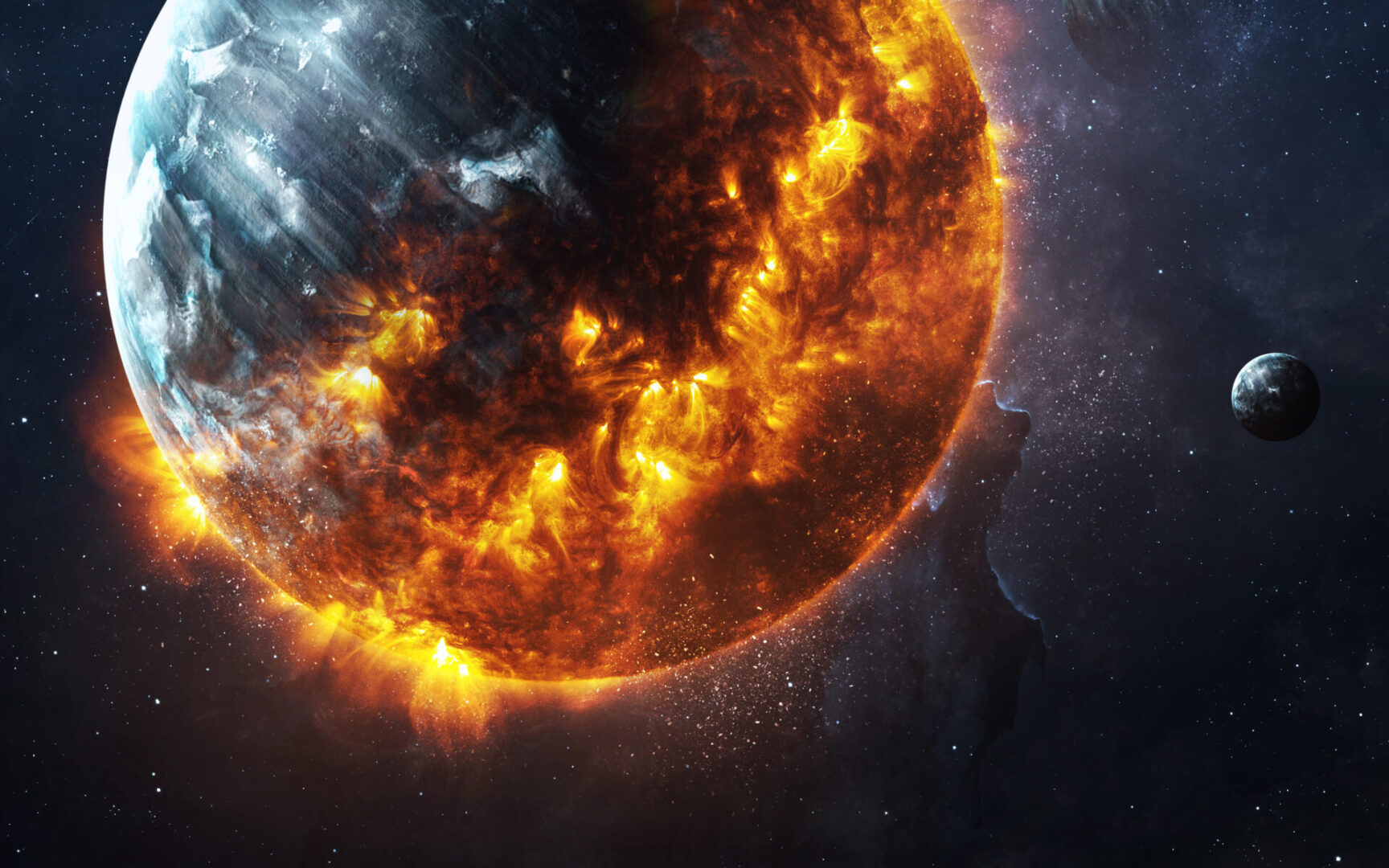The Elements Will Melt with Fervent Heat

“The Heavens will be dissolved, being on fire, and the elements will melt with fervent heat” (2 Pet. 3:12).
Many Christians believe God will one day destroy the planet, based on this prophecy from Peter, which he uttered in approximately AD 63. But is that really what Peter meant?
First, the Greek word for “elements” (in 2 Pet. 3:12) is stoicheion. This word is used only five other times in the New Testament. It is translated as “elementary principles of the world” in Galatians 4:3 and 4:9 (ESV); it is translated as “basic principles of the world” in Colossians 2:8 and 2:20–22 (NKJV); and it is translated as “basic principles of the oracles of God” in Hebrews 5:12–13 (NKJV). These are the only passages besides 2 Peter 3 that use the Greek word stoicheion. And in these other passages, it is clear that stoicheion refers to the Old Covenant (the Law)–not planet earth.
For example, in Galatians 4:3, Paul says: “In the same way we also, when we were children, were enslaved to the elementary principles [stoicheion] of the world. But when the fullness of time had come, God sent forth his Son, born of woman, born under the law, to redeem those who were under the law” (italics mine). The “elementary principles” refer to the Law! Christ set Israel free from the Old Covenant Law. Paul then asks: “How can you [Jews] turn back again to the weak and worthless elementary principles [stoicheion] of the world, whose slaves you want to be once more? You observe days and months and seasons and years!” Here, Paul is imploring his fellow Jewish converts (to Christianity) not to revert back to the Law. The reason Paul mentions “observing days and months” is because the Law required Jews to observe feast days, Sabbath days, holy days, etc.
Clearly, the word “stoicheion” refers to the Old Covenant/the Law. Therefore, when Peter said (in AD 63) “the elements [stoicheion] will melt with fervent heat,” he meant the Old Covenant would melt with fervent heat. That is, the Old Covenant would end. And it did end, just a few years later, when the temple was destroyed in AD 70!
In fact, some commentators argue that the manner in which the temple was destroyed was the literal fulfillment of Peter’s prophecy. According to the first-century historian Josephus, the temple literally melted with fervent heat after a Roman soldier threw a burning brand inside the window of one of the temple chambers and set it on fire. “Ignition in the hot month of August was easy, and in a few minutes the flames were seen to ascend. A convulsive cry arose from the Jews as they beheld their beloved temple approaching its fate. They sprang to rescue, but extinguishment was beyond human effort.”[1] The temple, which represented the Old Covenant (Heb. 9:8–9), burned with fervent heat!
Second, Peter’s prophecy of the destruction of heaven and earth (“the heavens will be dissolved, being on fire, and the elements will melt with fervent heat and the elements will melt with fervent heat”–2 Pet. 3:12) was about to happen when Peter uttered it in AD 63. How can we be sure of this? Because Peter had just said in First Peter that he was living in the last days (1 Pet. 1:20), and that the “end of all things is at hand” (1 Pet. 4:7), and that “the time has come for judgment to begin” (1 Pet. 4:17). This is the same judgment Peter is still talking about in 2 Peter 3. Clearly, Peter expected the destruction of heaven and earth to happen soon.
How did Peter know this? Because Jesus had said back in AD 33 (in the Olivet Discourse) that heaven and earth would pass away within a generation (Matt. 24:34–35). Therefore, by the time Peter wrote 2 Peter 3 in around AD 63, it was at the tail end of “this generation.” A biblical generation equates to around forty years (Heb. 3:8–10, Num. 14:30–34, Neh. 9:21). Thus, Peter expected the destruction of heaven and earth to happen soon. In other words, it must have happened in the first century. And if it happened in the first century, it cannot possibly refer to the destruction of planet earth.
Third, Peter knew from the Old Testament that life would continue on in the new heaven and earth, which means he would not have predicted the planet’s annihilation (in 2 Peter 3:12).
Peter said in the next verse, “We, according to His promise [God’s promise in the Old Testament], look for new heavens and a new earth in which righteousness dwells” (2 Pet. 3:13, italics mine). Peter also said this event was “spoken about by the holy prophets [in the Old Testament]” (2 Pet. 3:2; see also 3:4 and 3:13). In other words, Peter was not prophesying anything new. In fact, scholars readily acknowledge that Peter was drawing from Isaiah 65, a passage about the new heaven and earth (Isa. 65:17). And what did Peter’s source, Isaiah, say about the new heaven and earth? Isaiah said people would build houses (v. 21), work (vv. 21–23), have children (v. 20), sin (v. 20), and die (v. 20). In other words, planet earth would not be destroyed. What would be destroyed, however, is the Old Covenant “world” of (unforgiven) sin and (spiritual) death, which Jesus overcame in the first century (Heb. 9:26, John 11:26).
Fourth, Peter described the destruction of heaven and earth using the same kind of apocalyptic language as the Old Testament prophets had used to describe previous destructions of heaven and earth. That’s right, heaven and earth had been destroyed before! Compare 2 Peter 3:12 to Isaiah 34:4:
“The heavens will be dissolved, being on fire, and the elements will melt with fervent heat” (2 Pet. 3:12).
“All the host of heaven shall be dissolved, and the heavens shall be rolled up like a scroll; all their host shall fall down” (Isa. 34:4).
Both passages use the same kind of apocalyptic language. Yet Isaiah 34:4 is describing the judgment of Edom, as the next verse says: “For My sword shall be bathed in heaven; indeed it shall come down on Edom” (v. 5). This judgment happened in around 600 BC. In fact, God used the Babylonians to carry it out.
So there’s no biblical reason to think Peter intended his description of the destruction of heaven and earth any differently than Isaiah had six centuries earlier. And since Isaiah 34 does not refer to the literal destruction of the planet, then neither does 2 Peter 3.
Here is another Old Testament prophecy of a destruction of heaven and earth:
“Behold, the day of the Lord comes cruel, with both wrath and fierce anger, to lay the land desolate; and He will destroy its sinners from it. For the stars of heaven and their constellations will not give their light; the sun will be darkened in its going forth, and the moon will not cause its light to shine. I will punish the world for its evil, and the wicked for their iniquity…Therefore I will shake the heavens, and the earth will move out of her place…And Babylon, the glory of kingdoms, the beauty of the Chaldeans’ pride, will be as when God overthrew Sodom and Gomorrah (Isaiah 13:9–19, italics mine).”
This destruction of heaven and earth refers to the judgment of Babylon, in the days of Nebuchadnezzar, which happened by 689 BC.
There’s no biblical reason to think Peter meant his apocalyptic description of the destruction of heaven and earth any differently than Isaiah had! In other words, since planet earth was not destroyed in 600 BC, it would not be this time either.
See my article “The Passing of Heaven and Earth” and my book The End Is Here: How the New Testament’s Prophecies Were Fulfilled for more about this issue.
Alex Polyak, The Bible Fulfilled 11/17/23
[1] Thomas Lewin, The Siege of Jerusalem by Titus, updated ed. Edited by Bradley S. Cobb (Cobb Publishing, 2016), 70.
